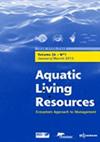Histology of Tritia mutabilis gonads: using reproductive biology to support sustainable fishery management
IF 1.9
4区 农林科学
Q3 FISHERIES
引用次数: 0
Abstract
The mutable nassa, Tritia mutabilis, a marine gastropod that is widely exploited on the Adriatic coast is an important source of income for small-scale fishermen in the Mediterranean Sea, particularly in the Gulf of Lion. However, the lack of knowledge on the ecology and biology of this species limits our capacities to propose and produce an effective management plan. As a result, stocks are currently declining, especially in Italy. In order to optimize a management plan for this fishery, we designed a study to better characterize the reproductive biology of T. mutabilis, using gonad histology and performing a regular monitoring of population size frequency. The average shell height of individuals during the breeding period was 24 ± 2.7 mm for males and 30 ± 3.7 mm for females. The presence of small females (10 mm) and large males (32 mm) in the whole sample challenged previous assumptions regarding protandry (sex change from male to female). The size at first maturity was estimated for males and females at 17.5 mm and 24.4 mm shell height, respectively. In Italy, current management measures include a minimum conservation reference size of 20 mm in shell height. Therefore, it is likely that many individuals that did not reproduce are being caught, which could partly explain the decline observed, despite conservation measures introduced more than ten years ago. Overall, our study provides some baseline information to establish, in consultation with fishermen, management measures for this small-scale fishery in France.
变异小偃麦草性腺组织学:利用生殖生物学支持可持续渔业管理
在亚得里亚海沿岸被广泛开发的一种海洋腹足类动物,是地中海,特别是狮子湾小规模渔民的重要收入来源。然而,由于对这一物种的生态学和生物学知识的缺乏,限制了我们提出和制定有效管理计划的能力。因此,库存目前正在下降,尤其是在意大利。为了优化该渔业的管理计划,我们设计了一项研究,利用性腺组织学和对种群大小频率进行定期监测,以更好地表征突变T.的生殖生物学。繁殖期个体平均壳高雄性为24±2.7 mm,雌性为30±3.7 mm。在整个样本中,小雌性(10毫米)和大雄性(32毫米)的存在挑战了之前关于原雄制(从雄性到雌性的性别变化)的假设。雄性和雌性初成熟时的壳高分别为17.5 mm和24.4 mm。在意大利,目前的管理措施包括贝壳高度的最小保护参考尺寸为20毫米。因此,很可能许多没有繁殖的个体被捕获,这可以部分解释观察到的下降,尽管十多年前引入了保护措施。总的来说,我们的研究提供了一些基线信息,在与渔民协商的情况下,为法国这种小规模渔业制定管理措施。
本文章由计算机程序翻译,如有差异,请以英文原文为准。
求助全文
约1分钟内获得全文
求助全文
来源期刊

Aquatic Living Resources
农林科学-海洋与淡水生物学
CiteScore
2.30
自引率
0.00%
发文量
10
审稿时长
>24 weeks
期刊介绍:
Aquatic Living Resources publishes original research papers, review articles and propective notes dealing with all exploited (i.e. fished or farmed) living resources in marine, brackish and freshwater environments.
Priority is given to ecosystem-based approaches to the study of fishery and aquaculture social-ecological systems, including biological, ecological, economic and social dimensions.
Research on the development of interdisciplinary methods and tools which can usefully support the design, implementation and evaluation of alternative management strategies for fisheries and/or aquaculture systems at different scales is particularly welcome by the journal. This includes the exploration of scenarios and strategies for the conservation of aquatic biodiversity and research relating to the development of integrated assessment approaches aimed at ensuring sustainable and high quality uses of aquatic living resources.
 求助内容:
求助内容: 应助结果提醒方式:
应助结果提醒方式:


